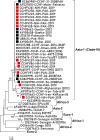Genetic diversity and phylogenetic analysis of Crimean-Congo Hemorrhagic Fever viruses circulating in Pakistan during 2019
- PMID: 32598383
- PMCID: PMC7351229
- DOI: 10.1371/journal.pntd.0008238
Genetic diversity and phylogenetic analysis of Crimean-Congo Hemorrhagic Fever viruses circulating in Pakistan during 2019
Abstract
Being an endemic country for Crimean Congo hemorrhagic fever (CCHF), this study aimed to explore the genetic diversity of CCHF virus (CCHFV) detected in Pakistan during 2019. Serum samples from patients with clinical signs of hemorrhagic fever attending tertiary care hospitals in Pakistan were tested for CCHFV RNA using real-time PCR at Department of Virology, National Institute of Health. The partial S-gene fragments were directly sequenced to determine the prevailing CCHFV genotypes and their molecular epidemiology in Pakistan. During January-December 2019, 280 samples from suspected CCHF patients were tested and 28 (10%) were found positive on real-time PCR. Positive cases were detected from 14 districts and across all four provinces of Pakistan with majority reported during August-September. The mean age of CCHFV positive patients was 37.25 years (range 5-65 years) with a high frequency in males (92.8%; n = 26) and a case fatality rate of 40.7% was observed. Phylogenetic analysis showed that S- segment of 2019 PAK CCHFV strains (n = 13) belonged to Asia-1 genotype and clustered with regional strains from Iran, Oman, and Afghanistan. We conclude that Asia-1 genotype of CCHF virus remains endemic in Pakistan. Our findings emphasize to establish a laboratory based surveillance program to monitor the disease burden and identify outbreak hotspots for effective control.
Conflict of interest statement
The authors have declared that no competing interests exist.
Figures



Similar articles
-
CCHF virus variants in Pakistan and Afghanistan: Emerging diversity and epidemiology.J Clin Virol. 2015 Jun;67:25-30. doi: 10.1016/j.jcv.2015.03.021. Epub 2015 Mar 28. J Clin Virol. 2015. PMID: 25959153
-
Genetic analysis and epidemiology of Crimean Congo Hemorrhagic fever viruses in Baluchistan province of Pakistan.BMC Infect Dis. 2013 May 4;13:201. doi: 10.1186/1471-2334-13-201. BMC Infect Dis. 2013. PMID: 23641865 Free PMC article.
-
Prevalence and phylogenetic analysis of Crimean-Congo hemorrhagic fever virus in ticks collected from Punjab province of Pakistan.Acta Trop. 2021 Jun;218:105892. doi: 10.1016/j.actatropica.2021.105892. Epub 2021 Mar 19. Acta Trop. 2021. PMID: 33753031
-
New aspects about Crimean-Congo hemorrhagic fever (CCHF) cases and associated fatality trends: A global systematic review and meta-analysis.Comp Immunol Microbiol Infect Dis. 2020 Apr;69:101429. doi: 10.1016/j.cimid.2020.101429. Epub 2020 Feb 5. Comp Immunol Microbiol Infect Dis. 2020. PMID: 32062190
-
Crimean-Congo hemorrhagic fever: history, epidemiology, pathogenesis, clinical syndrome and genetic diversity.Antiviral Res. 2013 Oct;100(1):159-89. doi: 10.1016/j.antiviral.2013.07.006. Epub 2013 Jul 29. Antiviral Res. 2013. PMID: 23906741 Review.
Cited by
-
Molecular detection and characterization of spotted fever group Rickettsia and Anaplasma in ticks from Pakistan.Parasitology. 2025 May;152(6):632-640. doi: 10.1017/S0031182025100358. Parasitology. 2025. PMID: 40509998 Free PMC article.
-
A comprehensive review on the epidemiology of arboviruses in the Eastern Mediterranean Region (EMRO): insights from the WHO's Regional Office.GMS Hyg Infect Control. 2025 Jun 27;20:Doc34. doi: 10.3205/dgkh000563. eCollection 2025. GMS Hyg Infect Control. 2025. PMID: 40657625 Free PMC article.
-
Knowledge, attitudes, and practices regarding Crimean-Congo hemorrhagic fever among general people: A cross-sectional study in Pakistan.PLoS Negl Trop Dis. 2022 Dec 8;16(12):e0010988. doi: 10.1371/journal.pntd.0010988. eCollection 2022 Dec. PLoS Negl Trop Dis. 2022. PMID: 36480553 Free PMC article.
-
Identification, Characterization, and Homology Analysis of a Novel Strain of the Crimean-Congo Hemorrhagic Fever Virus from Yunnan, China.Microorganisms. 2024 Jul 19;12(7):1466. doi: 10.3390/microorganisms12071466. Microorganisms. 2024. PMID: 39065234 Free PMC article.
-
A retrospective study of Crimean-Congo hemorrhagic fever in Iraq.Afr Health Sci. 2024 Mar;24(1):59-68. doi: 10.4314/ahs.v24i1.8. Afr Health Sci. 2024. PMID: 38962343 Free PMC article.
References
-
- Swanepoel R., et al., The clinical pathology of Crimean-Congo hemorrhagic fever. Reviews of infectious diseases, 1989. 11(Supplement_4): p. S794–S800. - PubMed
MeSH terms
Substances
LinkOut - more resources
Full Text Sources
Molecular Biology Databases

